Working with hay bales
Some hay bales weigh as much as 800kg, so it is important to understand the risks of working with them.
What do we mean by working with hay bales?
Hay bales can be small rectangular, large rectangular or large round. They are made of grass, lucence, straw, stubble, or other plant material that has been compressed, tightly bound, or baled together (including wrapped round silage bales). Baling happens on the field or paddock where the hay was grown and dried.
Feeding livestock is the main use for hay. It can also be used for animal bedding.
After the hay has been baled it is usually moved from the paddock into storage, stacked, and then moved again later for transport or use. Working with hay bales is the lifting and moving of the bales, usually with vehicles and machinery.
What are the risks of working with hay bales?
There are many hazards and risks associated with working with hay bales. These include:
- broken bones, fractures, and head injuries from falls from bale stacks and vehicles and machinery used to transport or stack bales, and from runover accidents
- crush injuries or death from being struck by falling or collapsing bales (well packed large bales can weigh up to 800kg) or from being struck by moving vehicles and machinery
- electrocution from contact with overhead powerlines
- trips and falls from loose bale string
- pinch, entanglement, and entrapment injuries, ranging from minor grazes to amputations and death) from contact with bale handling machinery
- burns from contact with haystack fires
- manual handling injuries, like sore backs, pulled muscles and strains, from lifting and carrying bales
- respiratory diseases and infections from exposure to dust.
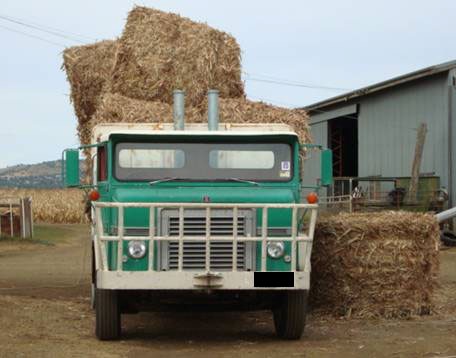
Photograph 1: Hay bales can fall from a truck during unloading.
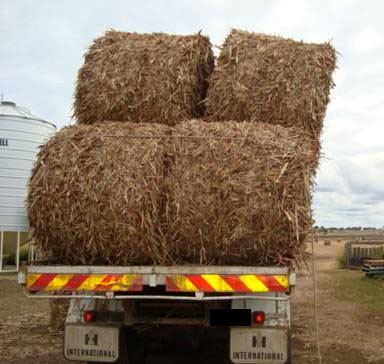
Photograph 2: Bales transported on their sides or inadequately secured can move while being transported.
How do I manage the risks?
Workers and managers should work together to reduce the risks of working with hay bales.
For workers
As a worker, you must:
- take care of your own health and safety as well as the health and safety of others
- cooperate with management to meet health and safety requirements and reduce risks.
For businesses
As an employer or business owner, you have legal responsibilities as outlined in the Work Health and Safety Act 2011 for the health and safety of every worker and visitor.
The four-step process below will help businesses to meet their legal obligations under work health and safety (WHS) laws.
Four steps to manage risk
The first step to manage the risk of harm to workers working with hay bales is to identify the hazards related to the work tasks and the environment.
Do this by inspecting your farm and your work processes. Ask yourself:
- Is the bale handling equipment properly designed for the job?
- Is the equipment well maintained?
- Are my workers properly trained in the tasks I’m asking them to do?
Talk to your workers and ask:
- Are you aware of any potential hazards?
- How can we improve our safety and our processes?
- Do you know how to report a hazard?
Regularly review your own records, and consider:
- What do your workers’ compensation claims, recorded incidents, sick leave and worker complaints tell you about past incidents and hazards?
- What can you do to prevent the same things happening again?
Next, assess the level of risk posed by each hazard. The risk level is determined by:
- how serious the potential harm is
- how likely it is to happen.
You can use this risk assessment template (DOCX, 0.02 MB) to guide you and record your assessments.
The law requires you to eliminate the risks if practical, or to minimise them as much as possible.
Work through the hierarchy of controls to choose the control that most effectively eliminates or minimises the risks. This may involve a single control measure or combination of two or more different controls.
Find the hierarchy of controls in How to manage work health and safety risks code of practice 2021 (PDF, 0.65 MB).
Some controls apply to all tasks when working with hay bales, including:
- ensuring workers are properly trained and able to perform the task safely
- using plant and equipment that is designed for the task, well maintained and in good working order
- working on flat and even surfaces, where possible.
Other tasks have specific controls, listed below.
Falling or collapsing hay bales:
- Stack bales according to Australian Fodder Industry Association guidelines.
- Use correct lashing techniques when tying down bales on vehicles.
- If using tarpaulins, ensure they do not disturb or dislodge bales.
- Before unloading, check that bales have not moved during transport.
- Develop a load and unload sequence that stops the load from becoming unstable.
- Fit tractors with a well-maintained falling object protective structure (FOPS).
- Use equipment designed for hay bale handling, such as telehandlers, hay bale clamps, grabs, and spikes.
- If using a front-end loader attachment, ensure it is self-levelling and has a backboard.
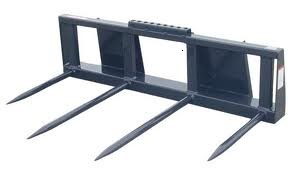
Photograph 3: Bale spikes.
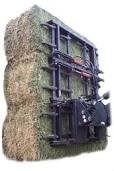
Photograph 4: Big bales grabs attached to a telehandler.
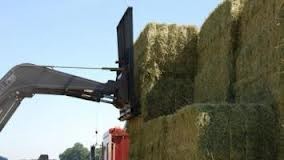
Photograph 5: Front end loader with large square bale.
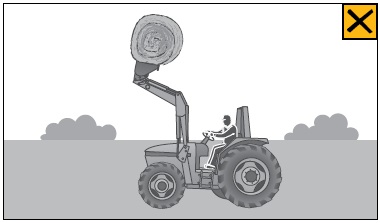
A tractor without FOPS puts workers at risk of injury from a falling hay bale.
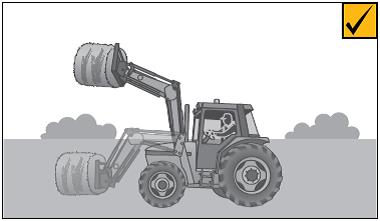
A self-levelling attachment will help balance the hay bale to prevent it falling. A backboard will prevent the bale falling backwards onto the operator.
(Diagrams courtesy of WorkSafe Victoria)
Stack configuration:
- Ensure bales are of equal size and density.
- Check lower bales are sound and can provide stability for upper layers.
- Ensure the load doesn’t exceed truck or trailer dimensions, nor the maximum allowed axle and gross weights.
- Never strap or unstrap bales while the trailer is still being loaded or unloaded.
- Never climb on top of the load to place straps or tarps, use a lifting cage instead.
Electrocution from contact with overhead powerlines:
You do not need to make direct contact with powerlines to receive an electric shock. Electricity can jump or arc across air gaps.
- Put exclusion zones (how far workers and their equipment must stay away from powerlines, poles and stay wires) in place as outlined in the Electrical Safety Act 2002.
- Ensure workers are aware of where overhead powerlines are, understand where the exclusion zones are, and know the height and reach of equipment they are using.
- Don’t load or unload near overhead powerlines.
- Don’t stand on trucks or trailers while loading or unloading near to overhead powerlines.
- Lower loading equipment, such as telescopic booms, masts of forklifts and front-end loader attachments when passing near or under overhead powerlines.
For more information about electrical safety and exclusion zones refer to:
- Electricity in the rural industry - Using it safely
- Electrical Safety Code of Practice 2010 Working Near Exposed Live Parts (PDF, 0.47 MB)
Following are examples of the clearances that people, machinery, and plant must maintain from powerlines.
Powerline voltage (1 kV = 1000 volts) | Examples | Exclusion zone* |
|---|---|---|
Up to 132 kV | Low voltage and high voltage powerlines – usually on poles | 3 metres |
Between 132 kV and 330 kV | Powerlines usually on poles and towers | 6 metres |
Over 330 kV | Powerlines usually on towers | 8 metres |
Falling from heights:
- Use mechanical equipment or aids to load or remove bales, and to assist with placing or removing lashings, tarps, or other securing devices to stop the need for workers to climb on the stack.
- Ensure there’s a safe way for workers to move up onto and down from work positions that are above ground level.
- Give workers a way to get up onto and down from truck or trailer beds that doesn’t need them to jump from heights.
Keeping bystanders safe:
- Set up an exclusion zone to keep bystanders (including truck drivers) from the loading zone.
- Ensure no-one is on the opposite side of the truck or trailer during loading or unloading.
- Nominate a spotter (who has communication to the mobile plant operator) to prevent people entering the loading zone area.
- Ensure driving routes are well defined.
- Never transport workers on loads or loading equipment.
- Use signs or barriers to keep members of the public or anyone not involved with the loading or unloading operation away.
You should regularly review your control measures. Don’t wait for something to go wrong. If necessary, change or adjust your approach. The aim is to maintain a work environment that is without risks to health and safety.
Work health and safety laws require you to review controls:
- when you become aware a control measure is not working effectively
- before a change that might introduce a new risk
- when you find a new hazard or risk
- when your workers tell you that a review is needed
- after a health and safety representative requests a review.
Standards and compliance
Codes of practice
- How to manage work health and safety risks code of practice 2021 (PDF, 0.65 MB)
- Rural plant code of practice (PDF, 0.63 MB)